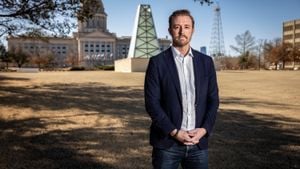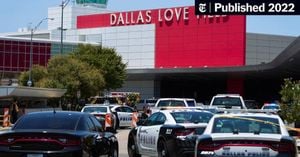Winnipeg is grappling with serious crime and public safety concerns recently, and it’s weighing heavily on local residents and officials alike. From rising violent crime rates to alarming incidents of sexual assault, the state of safety in the Manitoba capital is raising red flags. This story is about more than just numbers; it embodies the daily struggles locals face and poses questions about the effectiveness of current strategies to combat crime.
One of the latest reports from the Winnipeg Police Service reveals troubling trends. It indicates a marked increase in violent crimes, with shootings and stabbings dominating headlines. For many Winnipeggers, these statistics aren’t just numbers; they reflect the reality of unsafe streets.
Recent incidents include high-profile shootings and assaults, undermining community trust. Local business owners, like Susan, who runs a café downtown, shared their anxious reactions. “I never imagined I would have to worry about my safety or the safety of my customers,” she lamented. The unease is palpable, with people questioning their ability to walk safe streets or enjoy the city’s vibrant culture.
What’s fueling this uptick? Experts suggest various factors, including economic hardship and the mental health crisis exacerbated by the pandemic. The strain on local resources, coupled with the existing social issues, means many individuals are facing dire circumstances.
Interestingly, the police force is aware of these concerns. They recognized the need for intervention, announcing several initiatives aimed at addressing the rising crime. For example, there are plans for visible police presence and community engagement approaches to encourage cooperation.
Yet, not all responses are met with enthusiasm. Some community leaders argue these measures are merely band-aid solutions. They call for systemic changes rather than temporary fix-ups, emphasizing support for mental health and social services as fundamental parts of long-term solutions.
Recent discussions have ventured beyond just statistics; they include strategies for rehabilitation and proactive community-building. Initiatives aimed at youth engagement have begun to sprout, tackling crime from its roots rather than just focusing on punitive measures.
This broader approach aims to redirect the lives of vulnerable populations, reducing future crime rates. Local NGOs have stepped up to the plate, creating programs catering to at-risk youth, empowering them with education, mentorship, and career skills.
Public safety intersects significantly with societal partnerships. The Winnipeg community is experiencing collaborative efforts involving various stakeholders, including nonprofits, law enforcement, and residents. An open dialogue between community members and city officials has emerged, fostering trust and cooperation.
These discussions often bring up the effectiveness of municipal spending. Activists are urging city leaders to devote more resources to social programs rather than solely law enforcement efforts. “It’s about long-term strategies,” stresses community advocate Mark. “We have to invest where it matters most - our community's well-being.”
Despite the tense atmosphere, there’s hope. Recent community events highlight the resilience and strength of Winnipeggers. Neighborhood watches and community clean-up events have multiplied, signaling residents' determination to take back their streets.
Engagement efforts are not just limited to reactive measures. Local businesses are also joining forces, with initiatives aimed at creating safe spaces for residents to gather. Coffee shops and youth centers are transforming from simple venues to supportive environments where dialogue about safety can happen organically.
Meanwhile, tensions remain, and the fear surrounding crime is far from resolved. Recent statistics show nearly double the number of calls related to assaults have been received compared to last year, putting pressure not only on the police but also on hospitals and local emergency services, which have expressed growing concerns about their capacity to handle the influx of cases.
The city is also focusing on transparency and accountability. Recent community forums held by law enforcement aim to inform the public about safety measures and gather feedback. “Community input is invaluable,” says Chief of Police Smith. “We need to adapt our strategies to what the community feels is necessary.”
With winter approaching, the added layer of seasonal challenges complicates matters. Reduced daylight and colder temperatures often spur higher crime rates, as many individuals seek warmth and shelter. This reality raises concerns among social workers and local activists who worry about the more vulnerable populations during these months.
Those statistics, those alarming headlines—they’re stirring something within the community. People are becoming increasingly vocal about their needs for change. Town halls and community gatherings are witnessing passionate pleas for sustainable solutions, echoing the collective desire for safety and wellbeing.
One particularly poignant moment took place during the latest town hall when parents openly discussed the impact of crime on their children. “I used to let my kids play outside,” shared one mother. “Now, I’m constantly worried about their safety.” Their fears resonate deeply, highlighting how crimes transform community dynamics and parental autonomy.
Interestingly, as complaints rise, so do the efforts to shift narratives from danger to resilience. Grassroots movements are actively promoting stories of community members aiding one another, stepping up to take action. This narrative shift fosters hope and ignites collective action, breathing life and energy back to the community.
Still, legal, and safety experts continuously remind the community of the importance of due process. Calls for stricter penalties sometimes clash with calls for reform, leaving gray areas and dissatisfaction. For regular citizens, this can all seem confusing, with competing priorities on how to combat crime effectively.
Authorities, community members, and advocates recognize there’s no one-size-fits-all answer to the rise of crime and safety threats. Moving forward, it may require continuous adaptation of strategies, embracing new models like community policing and restorative justice frameworks.
Innovative programs and collaboration across sectors might just be the key to creating sustainable solutions. The resilience of Winnipeg’s residents continues to shine through the dark clouds. They refuse to be defined solely by crime statistics. Instead, they’re rallying to forge safer communities, reminding each other time and time again: there’s power when a community stands united.



